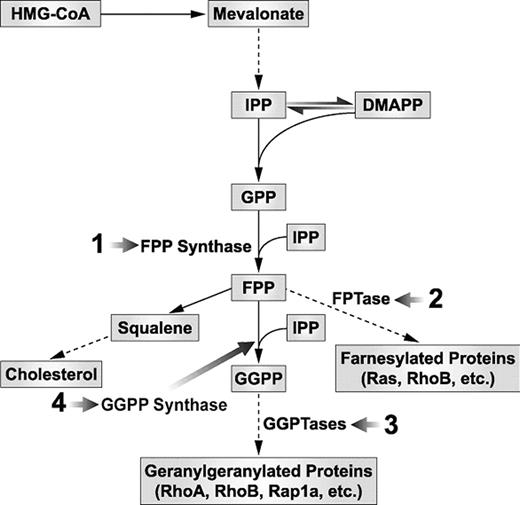Abstract
Zoledronic acid (ZOL), an aminobisphosphonate, is used in the clinic to prevent pathologic resorption of bone by osteoclasts in multiple myeloma. ZOL may also have direct anti-myeloma activity, perhaps through inhibition of farnesyl pyrophosphate (FPP) synthase. FPP synthase is an enzyme in the isoprenoid biosynthetic pathway (step 1 in figure). This pathway is responsible for the production of isoprenoid pyrophosphates. These may be covalently linked to small GTPases; the addition of the 15 carbon farnesyl moiety is termed farnesylation (step 2) and the 20 carbon geranylgeranyl moiety is geranylgeranylation (step 3). These post-translational modifications of small GTPases allow for proper membrane association that is necessary for normal signal transduction. To further elucidate the role of FPP synthase inhibition as a potential mechanism of action of ZOL, a human derived myeloma cell line, RPMI-8226 was incubated with 50 microM ZOL for 24 hours. ZOL diminished isoprenylation of Ras, Rab 6 and Rap 1A, as determined by Western blotting. Addition of 10 microM of geranylgeranyl pyrophosphate (GGPP) restored processing of these small GTPases. Processing was not restored with the addition of 1mM of mevalonate, 10 microM geranyl pyrophosphate (GPP), or 10 microM farnesyl pyrophosphate. As these latter components are upstream of FPP synthase these data suggest that ZOL may act by limiting availability of GGPP for isoprenylation. This is further supported by treatment of RPMI-8226 cells with a novel GGPP synthase inhibitor (step 4), which can be reversed by addition of GGPP but not by FPP. To more accurately mimic the marrow microinvironment, RPMI-8226 cells were incubated in an in vitro co-culture with murine derived osteoclasts. Briefly, bone marrow was harvested from C57B1/6 mice by flushing the long bones with culture media using a 31g needle. The cell suspension was centrifuged for 10 minutes and the cell pellet was resuspended in alpha-MEM containing 10% fetal bovine serum, 20 nM murine GM-CSF, 25nM PTHrP, 50 nM ascorbic acid, 10 nM Vitamin D3 and 1% penicillin/streptomycin. The bone marrow from two long bones was seeded in each 3.5 cm well and non-adherent cells were removed after 24 hours. This created a feeder layer which included osteoclasts, confirmed by TRAP staining. RPMI-8226 (4x106 cells/well) were added to the feeder layer on day six of the culture. The RPMI-8226 cells, normally a suspension cell line, became adherent to the feeder layer by 24 hours. They exhibited >95% viability confirmed by trypan blue exclusion. Under these conditions ZOL impaired protein isoprenylation by reducing geranylgeranylation but not farnesylation. These data further support the critical role of geranylgeranylation but not farnesylation of some small GTPases in myeloma cells. The co-culture system allows for further evaluation of the requirements of protein isoprenylation in myeloma cells and serves as an in vitro model to evaluate the impact of manipulating the isoprenoid pathway on osteoclast-myeloma interactions.
Author notes
Corresponding author


This feature is available to Subscribers Only
Sign In or Create an Account Close Modal